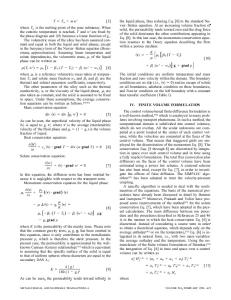Finite element prediction of the fatigue limit of steel
- PDF / 330,324 Bytes
- 3 Pages / 613 x 788.28 pts Page_size
- 47 Downloads / 444 Views
Finite Element Prediction of the Fatigue Limit of Steel WILLIAM J. BAXTER and PEI-CHUNG WANG The fatigue properties of a material are traditionally described by a stress-life (S-N) curve, i . e . , the relationship between the applied cyclic stress and the number of cycles required to cause failure. At low cyclic stresses, the fatigue life extends to 107 to 108 cycles and effectively defines a fatigue endurance limit or fatigue strength. Recently, we described a method tq of predicting this highcycle regime for precipitation-hardened aluminum alloys. The basic concept is that the rate-controlling process is the development of persistent slip bands (PSBs). We represented a PSB by a finite element model and calculated the strain field of the PSB and its environs under the action of a remote stress. We proposed that the elongation of a PSB is controlled by the plastic strain (ep) n e a r its tip and derived a fatigue damage (D) criteflon to describe the weakening of the matrix: D - e2
[1]
results are quoted in terms of the plastic strain in the matrix at a distance of 0.05/xm from the tip of the PSB. (Only the strain parallel to the direction of the applied stress is used, since it is always much larger than the other strain components). To evaluate our model, three properties are required for each steel: (1) the yield strength of the matrix, (2) the yield strength of the material in the PSB, and (3) the S-N curve. (1) The Matrix. A PSB grows into a matrix which has already been hardened by cyclic deformation. Therefore, as before, t~j the deformation of the matrix is represented by or(,.) = trots + 0.7e ~ MPa
where the very small hardening term is included to improve convergence. (2) The PSB. The material in the PSB is much weaker than the matrix, due to fatigue-induced microstructural changes, such as the destruction of precipitates, t2-5,61 A striking example has been provided by transmission electron microscopy of carbonitrided s t e e l 9 wherein the PSBs are denuded of precipitates. As in our previous article, tll we assume that the yield strength of the material in a PSB is a constant fraction of the ultimate tensile strength (UTS) of the matrix. After some preliminary calculations and comparisons with high-cycle fatigue data, we selected the following stress-strain law for a PSB in steel: or = 0.35OrUTS + 0.7e ~176MPa
or
ep = fiN} -~
[21
where NI is the fatigue life and/3 is a constant. The only adjustable parameters in the model are (1) the yield strength (%) of the material in the PSB and (2) the constant/3. This article describes the application of this model to some low and medium carbon steels. The results of the finite element calculations again correlate very well with S-N fatigue data taken from the published literature. Since the formation of a PSB during fatigue occurs initially at the free surface, the problem is simplified to two dimensions. Thus, the calculated plastic strain (ep) simply represents the resolved component, parallel to the surface, of the shear strain in the plane of the PSB.
Data Loading...











